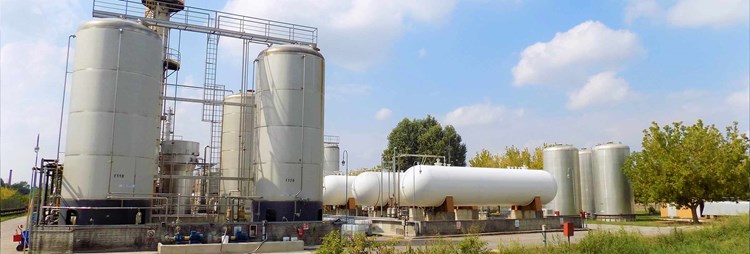Our expert responds #1
Question 1
We are designing a fire pump station for a textile manufacturer.
To meet the customer's requests, we are evaluating the possibility of reusing two 20 m3 vertical tanks in iron, 3 metres high, already present on the site.
The two tanks are not communicating vessels.
Can these tanks be used as water supply storage?
Should the installation to be used be positive head or suction lift?
The tanks can be reused. A suction manifold must be made towards the pumps, correctly sized. This is permissible if the application is suction lift.
The suction manifold is instead prohibited in the positive head applications UNI EN 12845 10.6.2
In any case UNI/TR 11438 (4.1.3) "Situations other than the single water supply storage must be engineered to guarantee in any case the performance required by the system, and to ensure the
continuity and reliability of the water supply for the entire expected duration, also with respect to the effects of the fire". Therefore, pay attention to the calculation of the manifold, the design flow rate must be guaranteed even when the tanks are at the minimum level.
The definitions that the standard states for the positive head and suction lift configuration, are contained in UNI EN 12845 10.6.2. On the basis of the information provided in the question, it is not possible to provide a universal answer.
Question 2
We often do maintenance onvery old fire extinguishers where there are electric pumps without a spacer joint.
We know that the new regulation prohibits this type of pump, how should we behave? Do they need to be replaced?
Can we still issue the customer with a test report in which we confirm that the pumps guarantee flow rate and prevalence?
If the unit has been built according to previous regulations (e.g. UNI 9490), it must not be modified to adapt it to the new rules that have been issued in the meantime.
This general consideration obviously applies, in the particular case of the absence of the spacer joint. The previous legislation did not provide for this, so it is not necessary to intervene on the unit, even if the successor standard instead imposes it for the new pressurisation systems.
However, the main pumps must be independently supported pumps, mounted on the base and connected to the electric motor by an elastic joint.
If the pumps are instead of the monobloc type, they must be replaced, because the previous legislation also prohibited them.
Tests on existing units, carried out according to any standard that has changed over time, must be carried out in accordance with what is stated in chap. 20 of UNI EN 12845, relating to MAINTENANCE.
Question 3
Is it always possible to install fire pumping stations consisting of electric pumps only? Or are there limitations?
The company already has a generator unit at the service of some machine tools that would largely cover the electrical absorption of the two pumps
Can the control panel of the pumps can be installed remotely from the pumps in a technical room where there are the other company control panels?
Water supplies that include pressurisation units composed of electric pumps only, are allowed only when a SINGLE-TYPE WATER SUPPLY is required for the protection of the activity.
Vice-versa, whenever a UPPER SINGLE-TYPE WATER SUPPLY is required, the pressurisation unit must be composed of at least two pumps, one of which must necessarily be driven by a DIESEL motor. See UNI EN 12845 9.0 – 9.6 – 10.2
Upper single-type water supplies are water supplies that guarantee a high degree of reliability. This increased reliability of the water supply is recognised by the standard only for composite systems as described above.
Pressurisation units consisting of only electric pumps, even if powered by a generator, are not considered to be HIGHLY RELIABLE.
So in summary:
What type of water supply should be provided?
• ONLY ELECTRIC PUMPS WITH OR WITHOUT GENERATOR UNIT ARE ACCEPTABLE, IT DOES NOT MATTER.
• UPPER SINGLE, SO THE UNIT MUST BE COMPOSED OF AT LEAST TWO MAIN PUMPS, ONE OF WHICH MUST BE OPERATED BY A DIESEL MOTOR. THE SUPPLY OF ELECTRIC PUMPS WITH A GENERATOR UNIT IN THIS CASE DOES NOT CREATE THE HIGHER RELIABILITY DEMAND OF THE SYSTEM.
The electrical panels must be placed inside the water plant system. See UNI EN 12845 10.8


